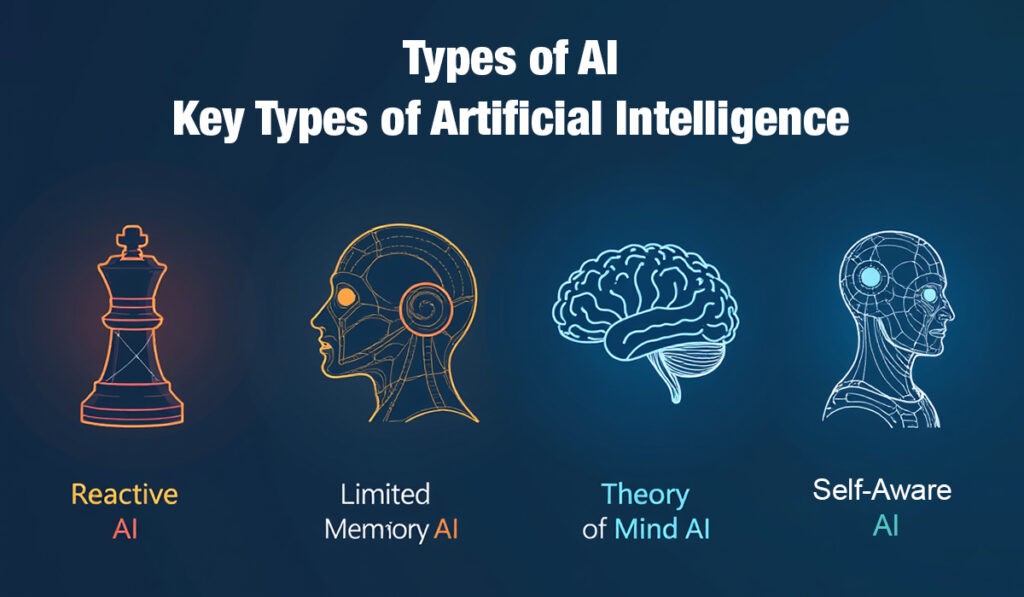AI is like a box of chocolates. Each piece looks attractive, but you’re not sure if you’re about to taste something sweet or surprisingly nutty. That’s how confusing the world of AI can feel or look. And you listen to talks of “machine learning,” “general AI,” and other fancy terms but what do they all mean, and where are they used?
Most people lump all types of AI into one big basket. This confusion leads to misuse, unmet expectations, or fear of robots taking over the world. Frustrating, right?
Let’s clear the air. This isn’t a techy crash course but sure it’s a fun and simple guide to understanding the key types of AI. By the end, you’ll not only know the differences between the Artificial Intelligence types but also see how they work in your everyday life. Ever wonder if your favorite streaming service is smarter than you think? Keep reading to find out!
What is AI? A Quick Overview
AI stands for Artificial Intelligence, which is just a fancy way of saying “smart machines.” These machines are programmed to think, learn, and solve problems, much like humans. For example, AI can help your phone predict what you’re typing or recommend a movie you’ll love.
But sometimes AI feels like a Swiss Army knife (multi-tool knife). Just like the knife has multiple tools for different tasks, AI comes with various abilities. It can guide you through traffic (like Google Maps), translate languages (like Google Translate), or even guess how you feel based on your text messages. Cool, right?
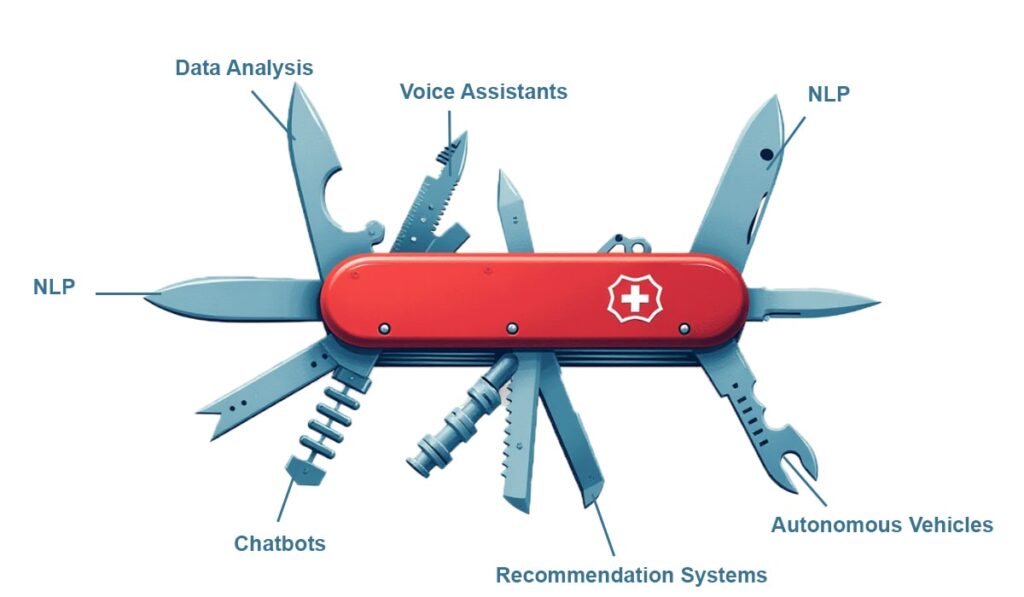
Learning about the types of AI or Machine learning types helps people and businesses make better decisions to work better. Imagine choosing the wrong tool from the Swiss Army knife to cut a rope that would be frustrating! Similarly, knowing which types of AI work best for specific tasks helps you to pick the right tool. If you’re going to search for customer support, data analysis, or personal assistants.
AI becomes one smart solution at a time.
Categories of AI: Capabilities-Based Classification
Here are capabilities-based categories that help you understand where AI is today and where it could be going tomorrow. With each step, AI is getting smarter, but it’s still a long way from being able to truly think and feel like a human truly. Let’s learn about these artificial intelligence categories:
a) Reactive AI: The Taskmasters
Reactive AI is like a robot with a one-track mind. It doesn’t remember anything from the past—it just focuses on the task at hand. Once the job is done, it forgets about it.
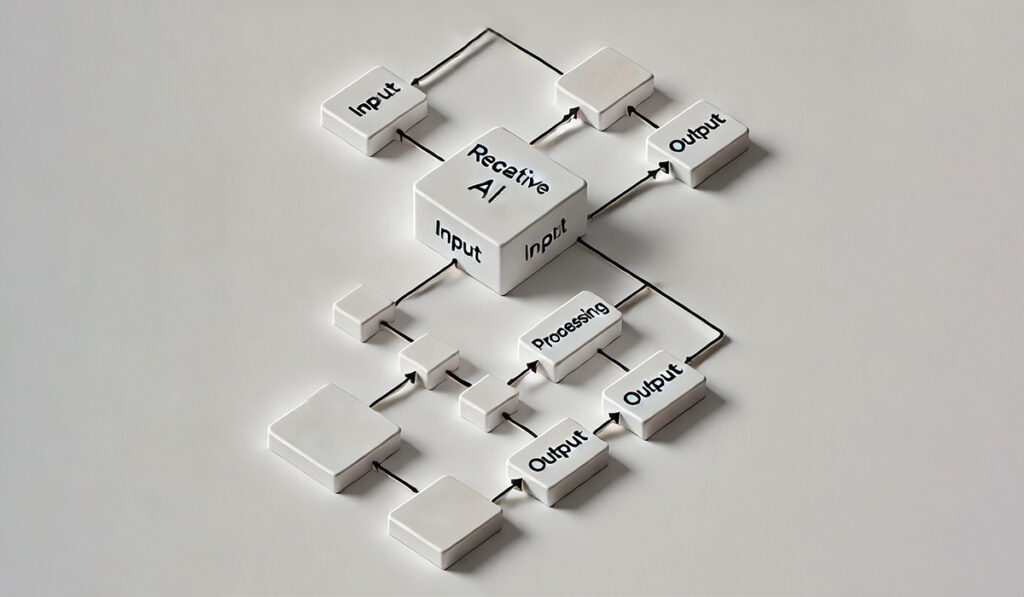
Think of Deep Blue, the famous chess-playing AI. It knew how to play chess but didn’t remember previous games. Another example is Netflix recommendations: it only suggests movies based on what you’ve watched recently.
These AI systems are great at specific tasks but struggle with anything new or unexpected. They can’t adapt to changing situations on their own.
b) Limited Memory AI: The Learners
Limited Memory AI is a little smarter. It can learn from past experiences and use that knowledge to make better decisions. For example, if you have an AI that’s been trained on lots of data, it can improve its performance over time.
ChatGPT learns from conversations to improve its responses. Autonomous vehicles also use this kind of AI to navigate by remembering road conditions and previous driving situations.

While it learns, Limited Memory AI still can’t think or reason like humans. For example, it can recognize patterns in data, but it doesn’t understand the “why” behind them the way we do.
c) Theory of Mind AI (Emerging)
This type of AI is still in the early stages, but it’s designed to understand things like emotions, intentions, and social cues—basically, it’s trying to think like humans do!
Imagine a robot therapist that can pick up on your feelings or an AI teacher that understands when you’re frustrated with a lesson. It could be super helpful in fields like therapy or education.
Right now, very few blogs dive deep into how this kind of AI could change things like human interactions. As it develops, it might be able to have more natural conversations and even understand what people need emotionally.
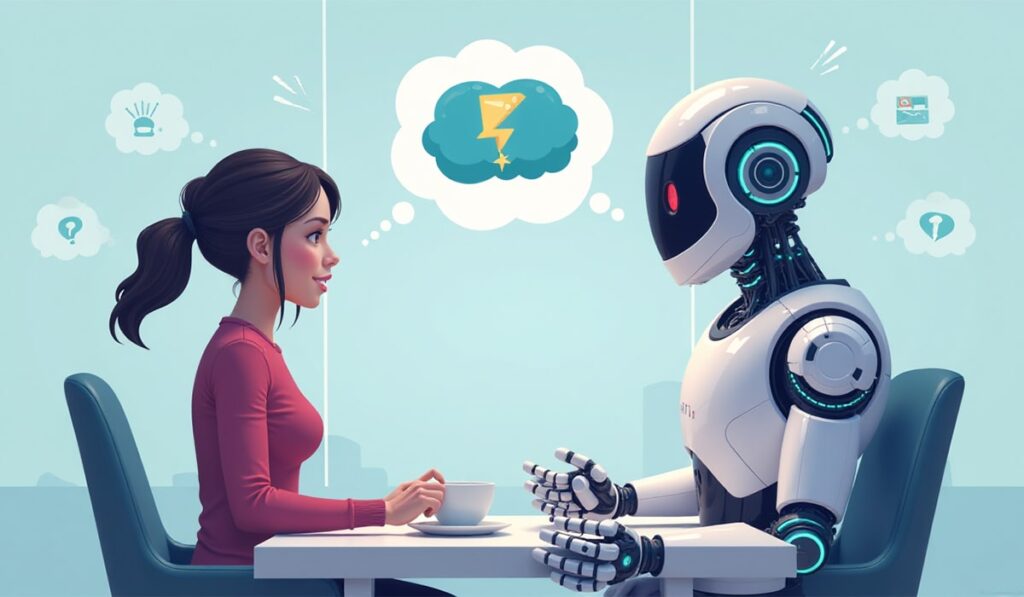
d) Self-Aware AI: The Sci-Fi Dream
This is the type of AI that we often see in science fiction movies, where robots are aware of their own existence. They’re more than just programmed machines—they understand that they’re “alive” in a way.
Imagine a robot who one day realizes it’s more than just wires and metal. It starts thinking about its purpose, like humans do. That’s the stuff of movies like The Terminator or Ex Machina.
Right now, self-aware AI is just a dream, but who knows? Maybe in the future, we’ll have robots that can understand not just tasks, but themselves.
Types of AI by Functionality: The Specialists
There are three types of AI based on functionality. We can understand that we’re not just talking about robots with fancy skills. Some AI is already here, and others are still in the realm of imagination. As we develop new technologies, we must think carefully about their potential and risks to make sure that we use them safely and wisely.

What’s waiting…… looking down to know what these are? like Narrow AI vs. general AI.
1. Narrow AI (Weak AI)
Narrow AI is really good at doing just one thing—and doing it well. It’s like a specialist who focuses on one task and masters it. Imagine a robot that can play chess, but it can’t do anything else, like write a story or make a sandwich. This is Narrow AI. It works only within its pre-set boundaries. Here are some examples to better understand this one type.
- Siri and Alexa: These voice assistants are great at answering simple questions, setting reminders, or playing music. But they can’t say, write an essay or create a painting. They are designed to excel at specific tasks, like recognizing voice commands.
- Translation Tools: Google Translate is another example. It’s fantastic at translating languages, but it can’t do anything outside of that task.
Narrow AI helps in everyday tasks and is already part of our lives. It’s in smartphones, cars, and even in tools used by doctors and lawyers. It saves time and effort by making repetitive tasks easier for us.
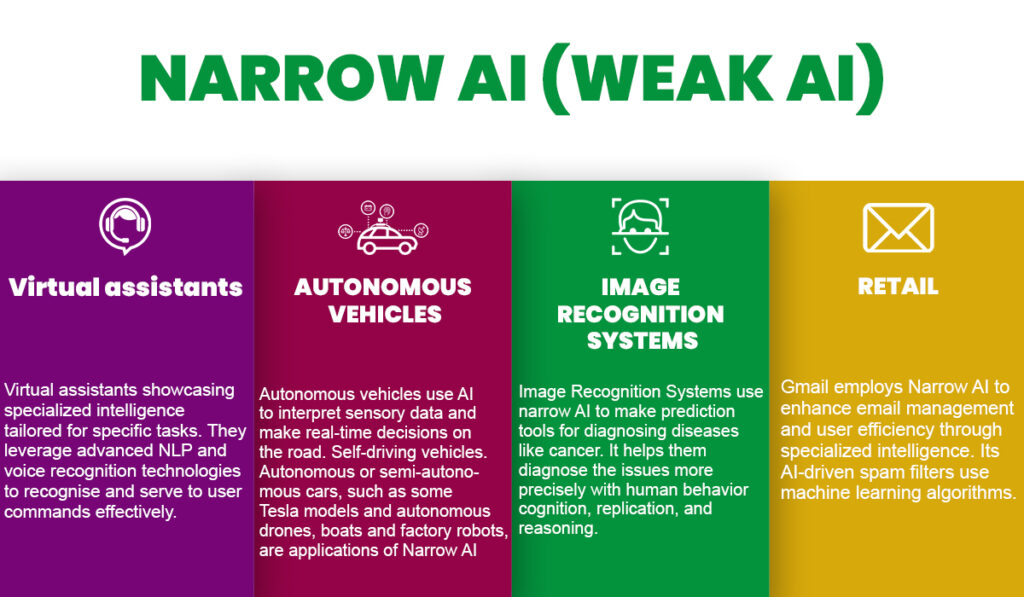
2. General AI (AGI)
General AI is a dream AI—an AI that can think and understand things like a human. It’s as if a robot could not only play chess, but also write a novel, solve math problems, and even understand emotions! It’s called Artificial General Intelligence (AGI) and doesn’t exist yet.
At the moment, we don’t have a real-world example of AGI. Scientists and researchers hope that in the future, we can build AI that can do anything a human brain can do.
If AGI is developed, it raises big questions: Would it have emotions? Could it make decisions without us? How do we make sure it’s safe? These are concerns we don’t have to think about with Narrow AI because it’s limited to specific tasks.
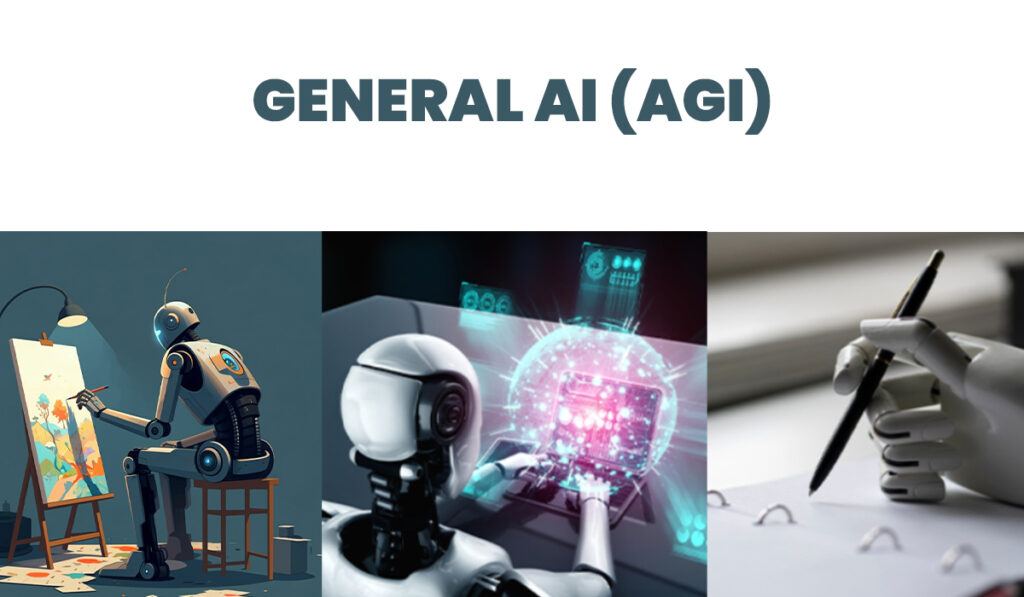
3. Super AI
Super AI is the ultimate AI—imagine a robot that is smarter than humans in every way. Super AI would be able to learn faster, solve complex problems, that’s why it’s called Superintelligent AI. Even it can create new ideas that humans couldn’t come up with.
“Will robots outsmart humans one day?” This is the big question with Super AI. Right now, it’s only a theory, and scientists are still debating if it’s even possible. Some believe that one day, AI might surpass our intelligence and make decisions that we can’t predict.
The idea of Super AI can be a little frightening because if AI gets smarter than humans, it might do things that we can’t control. Who would be in charge of it? It’s the stuff of science fiction, but with all the advancements in AI, some experts think it might not be as far off as we think.
Use Cases for Each AI Type
1. Reactive Machines: The Simple Problem Solvers
- Gaming Algorithms (e.g., Chess Bots): Reactive AI can play games like chess by following rules and strategies without thinking ahead or learning from past games. It just reacts to the current move, like a player who only thinks about their next move.
- Assembly-Line Robots: These robots work in factories to assemble products, reacting to the parts in front of them and performing tasks like tightening screws or welding. They don’t remember anything—they just do one thing at a time.
2. Limited Memory AI: The Learners
- Predictive Analytics in Marketing: Limited Memory AI helps businesses predict trends by analyzing data from the past. For example, it can look at your previous purchases and suggest products you might like, just like how online stores show you ads based on what you’ve searched for before.
- AI in Navigation Systems (e.g., Google Maps): AI in apps like Google Maps uses past traffic data to predict the fastest route to your destination. It “remembers” traffic patterns from the past but forgets them quickly to always give you the best option.
3. Theory of Mind AI (Future): Understanding Emotions
- Emotionally Aware Virtual Assistants: Theory of Mind AI is still in development, but it could someday help virtual assistants understand your mood and emotions. For example, an AI assistant might recognize when you’re upset and respond in a calming, understanding way.
- AI in Human Resources for Better Hiring Decisions: In the future, Theory of Mind AI could help HR departments by understanding candidates’ emotions and social cues during interviews, making hiring decisions more thoughtful and human-like.
4. Self-Aware AI (Hypothetical): Thinking Independently
- Advanced Healthcare Advisors: Imagine an AI that can think for itself, understand your health, and make decisions like a human doctor. It could give personalized advice, but we are still far from making this type of AI.
- Space Exploration Companions: If we ever send AI to space, a Self-Aware AI could think independently to help astronauts make decisions in unknown environments. It could be like a smart companion that learns and adapts to new challenges.
A Table for Quick Comparison
Here is a table for quick understanding of comparison of different types:
AI Type |
Key Feature |
Real-World Use |
Analogy |
Reactive AI | Handles specific tasks without memory | Spam filters, Netflix recommendations, Chess bots | A calculator solving a math problem |
Limited Memory AI | Learns from past data but forgets quickly | ChatGPT, autonomous vehicles, fraud detection | A goldfish remembering its last swim |
Theory of Mind AI | Understands emotions and social cues | Therapy bots, education, social robotics | A robot therapist that understands feelings |
Self-Aware AI | Hypothetical AI that is conscious | Advanced healthcare advisors, space exploration | A wise owl writing its life story |
Narrow AI (Weak AI) | Excels in one task, performs it well | Siri, Alexa, translation tools | A calculator that only does basic math |
General AI (AGI) | Matches human cognitive abilities (aspirational) | Hypothetical—no real-world instance yet | A robot that can think and learn like a human |
Super AI | Surpasses human intelligence (theoretical) | Hypothetical—no real-world instance yet | A robot outsmarting human in every way |
Tips for Choosing the Right AI for Your Needs
When choosing the right AI for your business or project, the first thing you need to do is understand the problem you want to solve. It’s like trying to pick the right tool for the job—you wouldn’t use a hammer to tighten a screw, right? Similarly, you should match your needs with the AI that suits them best.
Checklist to Help You Choose:
- Reactive AI: Is your task simple, like sorting emails or playing chess? Reactive AI is great for this, as it handles specific tasks without learning.
- Limited Memory AI: Do you need AI that learns from past data? Think about using limited memory AI for things like self-driving cars or personalized recommendations.
- Narrow AI: If you need AI to do one thing really well—like translating text or providing voice commands—then Narrow AI is your best friend.
Don’t give your chatbot a task better suited for a supercomputer, it’ll just give you the silent treatment!” So, always choose the right AI for the right job to avoid disappointment.
The key takeaway is that understanding the problem first will guide you to the perfect AI solution for your needs.
AI: Your Ultimate Toolbelt for the Future
AI is changing the way we think about technology. To grow in this Artificial intelligence technology, it is very necessary to understand its different types. Each type of AI—Reactive Machines, Limited Memory, Theory of Mind, and the futuristic Self-Aware AI—has its own unique strengths and abilities. Knowing how these types work helps us figure out how to use them in our lives and businesses.
AI is like a toolbelt. A Reactive Machine is like a hammer—simple but powerful for specific tasks. As we move up to more advanced types, the tools become smarter. One day, if we reach Self-Aware AI, it will be like having an architect who designs and plans everything for us.
So, what’s next for you? Start by exploring which type of AI fits your needs. Are you looking for a tool to analyze data, automate tasks, or improve customer experiences? Dive in, experiment, and discover how AI can help you achieve your goals. The future is waiting—grab your toolbelt and start building!

FAQs
What are the two main types of AI models?
The two main types of AI models are Machine Learning (ML) and Deep Learning (DL).
- Machine Learning types teaches computers to learn from data and improve over time.
- Deep Learning is like a super-advanced form of ML, using layers of processing (like a brain) to solve complex problems like recognizing faces or understanding speech.
Is Siri an AI?
Yes, Siri is an AI! It uses a type of AI called Natural Language Processing (NLP) to understand what you say and respond. Siri can set reminders, answer questions, and even tell jokes—all thanks to AI.
Who is the father of AI?
The “father of AI” is John McCarthy. He invented the term “Artificial Intelligence” in 1956 and worked on making machines that could think and solve problems like humans.
What is Apple’s AI?
Apple uses AI in many products. They have things like Siri for voice assistance, Face ID for unlocking your phone, and even AI-powered suggestions in apps like Photos and Messages. Apple’s AI focuses on making your life easier and your device smarter.
Is AI a technology or not?
Yes, AI is a technology. It’s a branch of computer science that helps machines learn, think, and solve problems. It’s used in apps, games, and even robots.
Is AI good or not?
AI can be both good and challenging.
- It’s good because it helps us save time, make better decisions, and solve problems faster.
- But it also raises concerns about job replacement or privacy, so we need to use it responsibly.
What is ChatGPT AI?
ChatGPT is an AI chatbot made by OpenAI. It understands your questions, gives answers, and even helps you write essays or solve problems. It’s like having a smart assistant who’s always ready to chat!

